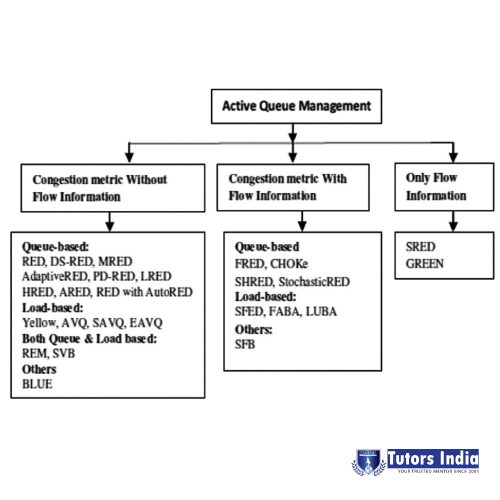Metrics used for Evaluating Queue Management Algorithms
Introduction
Congestion Control has a substantial impact on the performance of Transmission Control Protocol (TCP). Over the ages, several experts have conducted extensive study and proposed a number of enhancements to traditional TCP Congestion Control. TCP is one of the most widely utilized Internet protocols for traffic control and congestion, which means that TCP performance, is determined by its efficiency. TCP utilizes a congestion management technique to guarantee that the network is not overburdened by the transmitter by controlling the rate of information obtained by the transportation layer [1]. Because the pace of data transfer through networks is increasing all the time, it’s more important than ever to make sure network congestion is avoided or resolved as soon as it happens.
A queue management system can regulate the size of a channel’s queue. The mechanisms of such systems might be active or passive. Droptail is a passively congestion control system that drops packets when the queue is full, whereas Random Early Detection (RED) is an aggressive queue management system that decreases network packets even before the buffer is full. Active Queue Management (AQM) is crucial because it is thought that there is a straightforward trade-off between throughput and latency, and that queues must be kept in a “non-full” condition, implying that a low end-to-end delay is more important than a high degree of performance.
Part custom Coding and algorithm service and thesis writing services at Tutors India are handled and written by the style, design, and format of an ideal manuscript required by the UK, Australia, and the US universities.
The buffering procedure in a network is designed to absorb data surges and send them onward during inevitable bouts of stillness [2]. The TCP congestion control mechanism is critical to the Internet’s current resilience. People can’t rely on end users to implement adequate congestion control when more UDP applications (e.g. packets video/audio apps) are deployed on the Internet.

Architecture of Active Queue management system [3]
Queue Management Algorithms
RED (Random Early Drop)
RED was created with the goals of minimizing link failures and queuing time, avoiding global source synchronization, maintaining high link usage, and removing biased against high – bandwidth sources. The primary idea underlying RED queue management is to identify impending congestion immediately and to notify end-hosts of the congestion, enabling them to lower their transmission speed before network queues overflow and packets are discarded. While RED is a significant improvement over typical drop tail queues, it still has a few of flaws.
One of the major flaws with RED is that it uses queue length as a predictor of congestion. While the presence of a persistent queue shows that there is a problem, the length of the backlog provides little information about the severity of the problem [4]. That is, the quantity of competitive connections that share the same connection. A single source transmitting at a rate greater than the bottleneck link capacity might cause a backlog to form just as readily as a large number of sources during a busy time. The RED algorithm has an inherent issue detecting the degree of congestion because it is based on queue lengths.
FRED (Flow Random Early Drop)
FRED (Flow Random Early Drop) is a revised form of RED that makes various discarding options for connections with varied bandwidth usages based on per-active-flow accounting. FRED only maintains track of flows with packets in the buffer, hence its cost is proportional to the buffer size and unrelated to the overall number of flows (including the short-lived and idle flows). With FRED, you can get the advantages of per-flow queue and round-robin planning with a lot less effort.
Non-adaptive flows are penalized by applying a largest number of buffered bits and a ratio of their proportion of average per-flow buffer consumption [5]. Also safeguards fragile flows by accepting low bandwidth connections deterministically.
BLUE
BLUE is an interactive queue management technique that uses packet loss and connection use statistics instead of buffer capacity to handle congestion control. BLUE keeps just one probability for marking (or dropping) packets. If the queue is discarding transmissions due to buffer overflow, BLUE raises the pace at which something sends back congestion notifications or drops packets. If the queue gets empty or the channel is inactive, BLUE reduces the likelihood of marking. This basically allows BLUE to “learn” the proper pace at which it should send back congestion notifications or packets that have been dropped. To know more details and to get the best experts help to learn more about queue management system kindly contact Tutors India. Order Now
SFB
Stochastic Fair Blue (SFB) is a new approach for safeguarding TCP connections from non-responsive flows that is based on BLUE. SFB is a FIFO buffering algorithm that uses accounting similar methodologies to those used by BLUE to identify and rate-limit non-responsive flows. Accounting bins are kept at SFB. The bins are divided into L levels, each of which has N bins. SFB also keeps track of L different hash functions, each one connected with a different level of accounting bins. A flow is mapped into one of the accounting bins in each level by each hash function. Accounting bins are being used to keep a record of queue occupancy data for packets in each bin.
CHOKe
CHOKe, as a queue management algorithm, differentiates between non-responsive and hostile flows based on the flow’s queue buffer occupancy information. CHOKe uses an exponentially moving average to calculate the average capacity of the FIFO buffer, much as RED [6]. On the buffer, it additionally indicates two thresholds: a minimum and a maximum. Tutors India has the best experience in these queue management algorithms and to know more about it kindly contact. Talk to expert.
References
- Cao, R. Ji, L. Ji, M. Bao, L. Tao, and W. Yang, “Can Multipath TCP Be Robust to Cyber Attacks? A Measuring Study of MPTCP with Active Queue Management Algorithms,” Secur. Commun. Networks, vol. 2021, pp. 1–11, May 2021, doi: 10.1155/2021/9963829.
- M. Hamdi, H. F. Mahdi, M. S. Abood, R. Q. Mohammed, A. D. Abbas, and A. H. Mohammed, “A review on Queue Management Algorithms in Large Networks,” IOP Conf. Ser. Mater. Sci. Eng., vol. 1076, no. 1, p. 012034, Feb. 2021, doi: 10.1088/1757-899X/1076/1/012034.
- George and R. Santhosh, “Congestion Control Mechanism for Unresponsive Flows in Internet Through Active Queue Management System (AQM),” 2022, pp. 765–777.
- Khatari, A. A. Zaidan, B. B. Zaidan, O. S. Albahri, and M. A. Alsalem, “Multi-Criteria Evaluation and Benchmarking for Active Queue Management Methods: Open Issues, Challenges and Recommended Pathway Solutions,” Int. J. Inf. Technol. Decis. Mak., vol. 18, no. 04, pp. 1187–1242, Jul. 2019, doi: 10.1142/S0219622019300039.
- Li, X. Jiang, J. Zhu, and G. Jin, “SQM-LRU: A Harmony Dual-Queue Management Algorithm to Control Non-Responsive LTF Flow and Achieve Service Differentiation,” Sensors, vol. 21, no. 10, p. 3568, May 2021, doi: 10.3390/s21103568.
- Zeng, H. Ni, and R. Han, “The Yellow Active Queue Management Algorithm in ICN Routers Based on the Monitoring of Bandwidth Competition,” Electronics, vol. 10, no. 7, p. 806, Mar. 2021, doi: 10.3390/electronics10070806.

 Previous Post
Previous Post Next Post
Next Post